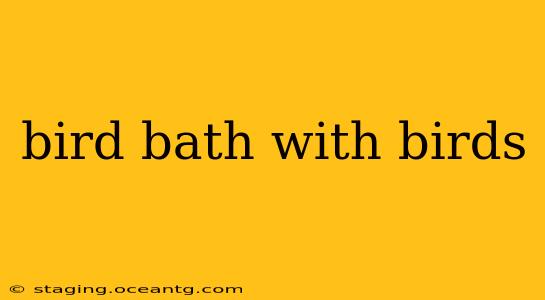Bird baths are more than just decorative additions to your garden; they're vital resources for birds, providing a crucial source of fresh water for drinking and bathing. A bird bath teeming with avian visitors is a delightful spectacle, bringing life and vibrancy to your outdoor space. This guide will explore everything you need to know about attracting birds to your bird bath and creating a welcoming habitat for these feathered friends.
What Kind of Bird Bath Attracts the Most Birds?
The type of bird bath that attracts the most birds depends on several factors, including the size of your garden, the species of birds in your area, and your personal aesthetic preferences. However, some features consistently prove popular:
- Shallow water: Birds prefer shallow water where they can easily reach the surface without needing to immerse their entire bodies. A depth of 1-2 inches is ideal for most species.
- Stable base: A wide, sturdy base prevents tipping, especially important for larger birds.
- Rough surface: A textured surface provides a grip for birds' feet, making them feel more secure.
- Multiple shallow dishes: Multiple smaller dishes, rather than one large bowl, offer more space and reduce competition between birds.
- Location: Consider placing the bath in a sunny location, but sheltered from strong winds, to keep the water warm and prevent splashing.
How Often Should You Clean a Bird Bath?
Cleaning your bird bath regularly is crucial for preventing the spread of diseases among birds. Aim to clean it at least once a week, more frequently in hot weather. Here's how:
- Empty the bath: Discard the old water.
- Scrub it thoroughly: Use a stiff brush and mild soap (avoid harsh chemicals) to remove algae, droppings, and other debris.
- Rinse it well: Ensure all soap residue is removed before refilling.
- Refill with fresh water: Provide a continuous supply of clean, fresh water.
What is the Best Placement for a Bird Bath?
Strategic placement is key to attracting birds. Consider these factors:
- Visibility: Place the bird bath in an open area where birds can easily see it from a distance.
- Protection: Offer some protection from predators like cats by placing the bath near shrubs or trees.
- Accessibility: Ensure the bath is easily accessible from nearby perches, such as branches or rocks.
- Sunlight: Aim for a location that receives at least some sunlight to warm the water. Avoid areas with direct, intense sun all day.
How Can I Attract More Birds to My Bird Bath?
Beyond a clean and strategically placed bird bath, you can take additional steps to attract more birds:
- Provide food sources: Supplementing with bird feeders will encourage birds to visit your yard more frequently.
- Offer shelter: Provide dense shrubs or trees for birds to hide in and feel safe.
- Avoid pesticides: Use natural pest control methods to protect birds from harmful chemicals.
- Add a shallow dish of water near plants: Some insects are attracted to water and these would attract insectivorous birds.
What Plants Attract Birds to a Bird Bath?
Planting native shrubs and flowers provides both food and shelter for birds, further enhancing the appeal of your bird bath. Research native plants in your region that offer berries, seeds, and nectar. These plants will attract the birds to your garden and your bird bath in the process.
Do I Need to Add Anything to the Water in a Bird Bath?
No, it's best to use plain, clean water. Adding anything to the water can be harmful to birds.
What Are the Benefits of Having a Bird Bath?
Providing a bird bath offers numerous benefits:
- Essential water source: Birds need water for drinking and bathing, especially during hot and dry periods.
- Improved bird health: Clean water helps prevent the spread of diseases.
- Increased biodiversity: Attracting more birds increases the biodiversity in your garden.
- Enhanced enjoyment: Watching birds at your bird bath is a delightful and enriching experience.
By following these guidelines, you can create a welcoming oasis for birds in your backyard, transforming your garden into a vibrant hub of avian activity. Remember, a little effort can go a long way in supporting these beautiful creatures and enjoying their presence.
